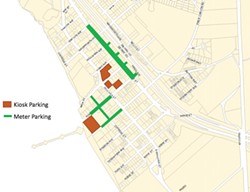Pismo Beach is planning to install scores of paid parking meters on Price Street in 2022, part of the city's effort to reduce traffic and parking congestion downtown in preparation for the potential loss of one of its biggest public parking lots.

- Screenshot From Pismo Beach Staff Report
- PAY TO PLAY Pismo Beach plans to install 146 meters along all curbs, the center median, and stub streets connected to Price Street between Pomeroy and San Luis avenues.
Pismo's second largest parking lot, the Wolosz lot, sits across from Old West Cinnamon Rolls at the intersection of Highway 1 and Pismo Avenue. It consists of two separate parcels, one that's owned by the Wolosz family and holds 76 parking spaces, and another that's owned by the city and holds 18 parking spaces. Both parcels are currently used by the city for public parking, but the city's lease on the larger portion is set to expire in April 2023, and staff say it's likely to be sold or developed in coming years.
Until the city can come up with a way to make up for those lost spaces, the plan is to install paid parking meters downtown to discourage visitors, employees, and beachgoers from sitting in parking spots for long periods of time.
"This is about ensuring that the premium parking for businesses, for restaurants, is always available, at least 85 percent booked and 15 percent available," City Manager Jim Lewis said at a City Council meeting on June 15, where council members voted 4-1 to install paid parking meters downtown. "So we're trying to manage available parking, and when employees get into a space prior to the peak time and occupy that space through the day, that parking is not available for customers, and so we're really trying to manage peak parking for customers. That's what the focus of this policy is."
The city plans to install 146 meters along all curbs, the center median, and stub streets connected to Price Street between Pomeroy and San Luis avenues at a cost of around $250,000. Metered parking will be charged on Fridays from noon to 6 p.m. and on Saturdays and Sundays from 10 a.m. to 6 p.m.
In an attempt to protect pedestrians using the meters, Community Development Director Matt Downing said the city should install a raised median in the center of Price Street between Pismo Street and Hollister Avenue. That work—which is expected to cost another $250,000—and the installation of the new meters will be folded into a paving project scheduled for the spring of 2022.
Downing said meter charges haven't been set yet, but could range from $1 to $8 an hour. A $2 an hour charge at all recommended meters would result in an estimated $263,000 in annual parking enterprise fund revenue, and $4 an hour would generate around $526,000, according to a city staff report.
"We don't anticipate getting anywhere near the maximum on Price Street," Downing said at the meeting.
City staff said the parking meters and the implementation of some 15-minute parking spaces on stub streets could help improve the flow of traffic downtown, allowing potential customers and visitors to make quick stops for food, drinks, or shopping, and discouraging the use of the downtown area for long-term beach parking.
But Councilmember Sheila Blake, who was the only member to oppose the paid parking plan, said the meters could make it more difficult for Pismo Beach employees to find parking near their places of work.
"I'm just kind of annoyed that it's always the employees that get run off," Blake said. "And there should be some way that these people are able to at least have the convenience of showing up at work on time."
Pismo Beach is also considering a number of ways to make up for the potential loss of the Wolosz lot, including the acquisition of various vacant lots and buildings to be used for parking, or the implementation of shuttle services. Most available options, however, would be prohibitively expensive. Δ
Comments